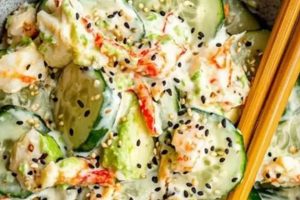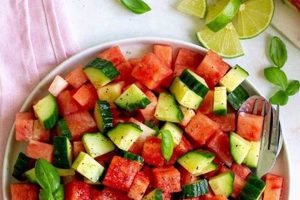A refreshing and crisp dish typically combines thinly sliced radishes and cucumbers, often with other complementary ingredients like onions, herbs, and a light vinaigrette. Variations can include different types of radishes and cucumbers, additions such as avocado or feta cheese, and a range of dressings from simple vinegar-based ones to creamy yogurt or buttermilk options.
This type of salad offers a cool, hydrating, and nutritious choice, particularly suitable for warmer weather. The vegetables themselves contribute vitamins, minerals, and fiber. Furthermore, the adaptable nature of the dish allows for customization to dietary preferences and seasonal ingredient availability, offering a versatile option for meals or side dishes. Such salads have a long history in various cuisines, appreciated for their simplicity and reliance on fresh produce.
This exploration will delve into specific ingredient selection, diverse preparation techniques, and optional additions to create a variety of flavorful and appealing salads. Nutritional information and tips for optimal storage and serving will also be provided.
Tips for a Perfect Radish and Cucumber Salad
Achieving optimal flavor and texture requires attention to detail in ingredient selection and preparation.
Tip 1: Choose Fresh, Firm Vegetables: Select radishes and cucumbers that are firm to the touch and free from blemishes. Peak season produce offers the best flavor and crispness.
Tip 2: Utilize Thin and Uniform Slices: Evenly sliced vegetables ensure a balanced flavor distribution and contribute to a pleasing visual presentation. A mandoline slicer or sharp knife can achieve this.
Tip 3: Salt and Drain Excess Moisture: Salting the sliced vegetables and allowing them to rest draws out excess water, preventing a watery salad and enhancing the flavors. Patting dry after draining is crucial.
Tip 4: Balance Flavors with Acidity: Incorporating an acidic element like vinegar or lemon juice brightens the flavor profile and complements the vegetables’ natural sweetness.
Tip 5: Explore Herb and Spice Combinations: Fresh dill, mint, parsley, or chives can elevate the salad’s aroma and taste. A pinch of black pepper or red pepper flakes can add a touch of complexity.
Tip 6: Consider Textural Variety: Toasted nuts, seeds, or crumbled feta cheese can add satisfying texture and enhance the overall sensory experience.
Tip 7: Chill Before Serving: Allowing the salad to chill for at least 30 minutes allows the flavors to meld and enhances the refreshing quality of the dish.
By following these guidelines, one can consistently create a delicious and visually appealing salad that showcases the fresh, vibrant flavors of radishes and cucumbers.
Following these preparatory steps ensures a consistently satisfying culinary experience.
1. Fresh Ingredients
Ingredient quality significantly impacts the overall success of a radish and cucumber salad. Freshness is paramount, directly influencing the flavor, texture, and visual appeal of the final dish. Utilizing high-quality produce elevates the salad from simple to exceptional.
- Radishes:
Firm, brightly colored radishes with crisp greens indicate freshness. Avoid any with soft spots or yellowing leaves. Different varieties, such as French breakfast or watermelon radishes, offer unique flavor profiles and visual interest.
- Cucumbers:
Choose firm cucumbers with smooth skin. Look for those heavy for their size, indicating higher water content. English cucumbers, known for their thin skin and minimal seeds, are particularly well-suited for salads.
- Herbs:
Fresh herbs provide aromatic complexity and vibrant color. Dill, mint, parsley, and chives are popular choices. Select herbs that are vibrant green and free from wilting. Adding herbs just before serving preserves their delicate flavors.
- Other Produce:
Optional additions like avocados, tomatoes, or bell peppers should also be chosen for peak ripeness and quality. These ingredients contribute additional nutrients, textures, and flavors to the salad.
Prioritizing fresh, high-quality ingredients ensures a vibrant and flavorful radish and cucumber salad. Careful selection results in a dish that is both visually appealing and nutritionally rich, maximizing the potential of this simple yet elegant culinary creation.
2. Precise Slicing
Precise slicing plays a crucial role in a successful radish and cucumber salad recipe. Uniformity of size and thickness contributes significantly to both the aesthetic appeal and the overall culinary experience. Thin, even slices ensure a balanced distribution of flavor, allowing the dressing to coat each piece effectively. This also creates a pleasing textural consistency, avoiding uneven bites where some pieces are too thick or too thin.
Consider the difference between a salad with roughly chopped vegetables and one with thinly and evenly sliced components. The former may result in some bites being overwhelmingly radish-flavored while others are predominantly cucumber. Precise slicing mitigates this issue, creating a harmonious blend of flavors in each bite. Furthermore, thin slices offer a delicate texture that complements the crispness of the vegetables, enhancing the refreshing nature of the salad. From a visual perspective, uniformly sliced vegetables elevate the presentation, making the salad more appealing and appetizing.
The practical significance of precise slicing extends beyond flavor and texture. Thin slices also facilitate even marinating and quicker absorption of the dressing, leading to a more flavorful and well-integrated salad. While various slicing techniques exist, achieving precision often involves using a sharp knife or a mandoline slicer. Mastering this technique ensures a consistently high-quality radish and cucumber salad, demonstrating attention to detail and culinary expertise. It transforms a simple dish into a carefully crafted culinary experience.
3. Balanced Dressing
A balanced dressing is essential for a successful radish and cucumber salad recipe. It provides the crucial link between the fresh, crisp vegetables and a cohesive, flavorful dish. The dressing’s role extends beyond simply adding flavor; it enhances the inherent qualities of the ingredients while contributing its own distinct character. A well-balanced dressing complements the natural sweetness of cucumbers and the peppery bite of radishes without overpowering their delicate flavors.
Consider a simple vinaigrette. The correct balance of acidity, sweetness, and oil is critical. Too much vinegar can make the salad overly tart, masking the subtle flavors of the vegetables. Conversely, insufficient acidity can result in a bland, uninspired dish. A touch of sweetness, often from honey or maple syrup, tempers the acidity and adds depth. The oil component, whether olive oil or a lighter alternative, provides richness and helps distribute the flavors evenly. A dressing lacking this element can feel thin and inadequate. For example, a lemon-dill vinaigrette with a touch of honey offers a bright, herbaceous counterpoint to the cool cucumbers and peppery radishes.
Creamy dressings, such as those based on yogurt or sour cream, offer a different dimension. These dressings provide a richer, more substantial coating for the vegetables. Balance remains crucial; excessive richness can overwhelm the delicate flavors of the salad. Adding herbs, spices, or a touch of lemon juice can brighten and lighten a creamy dressing, preventing it from becoming heavy. A dill-yogurt dressing, for instance, provides a tangy, creamy complement to the crisp vegetables. Achieving a balanced dressing, regardless of style, elevates the radish and cucumber salad from a simple combination of ingredients to a harmonious and flavorful dish, showcasing the synergy between fresh produce and a well-crafted dressing.
4. Complementary Herbs
The careful selection of herbs significantly elevates a radish and cucumber salad recipe. Fresh herbs contribute aromatic complexity and vibrant color, transforming a simple dish into a multi-sensory experience. Their delicate flavors enhance the inherent qualities of the vegetables, creating a harmonious and refreshing culinary composition. Choosing complementary herbs requires consideration of their individual characteristics and their interaction with the primary ingredients.
- Dill:
Dill’s slightly tangy, anise-like flavor complements the cool, refreshing nature of cucumbers and provides a subtle counterpoint to the peppery bite of radishes. Its feathery fronds also add visual appeal to the salad.
- Mint:
Mint’s bright, invigorating flavor adds a refreshing element to the salad. Different varieties, such as spearmint or peppermint, offer varying degrees of intensity. Mint pairs well with cucumbers, enhancing their inherent coolness.
- Parsley:
Parsley’s clean, slightly peppery flavor provides a subtle backdrop for the other ingredients. Both flat-leaf and curly parsley can be used, offering different textural and visual elements.
- Chives:
Chives offer a delicate onion flavor that adds a subtle savory note to the salad. Their slender, vibrant green stalks provide a visual contrast to the sliced vegetables.
The strategic use of these herbs elevates the radish and cucumber salad beyond a simple combination of ingredients. Their aromatic and flavor profiles intertwine with the vegetables, creating a more complex and nuanced culinary experience. The careful selection of herbs allows for customization and personalization, transforming a basic recipe into a personalized culinary expression.
5. Optimal Seasoning
Optimal seasoning is paramount in a radish and cucumber salad recipe. It elevates the inherent flavors of the fresh vegetables, transforming a simple combination of ingredients into a vibrant, balanced dish. Proper seasoning amplifies the delicate sweetness of cucumbers, balances the peppery notes of radishes, and creates a harmonious flavor profile. Neglecting this crucial step can result in a bland, uninspired salad that fails to reach its full potential.
- Salt:
Salt is foundational, enhancing the natural flavors of the vegetables and drawing out excess moisture. This not only improves the texture of the salad by preventing sogginess but also intensifies the taste of each ingredient. The type of salt used can also influence the final flavor profile. Kosher salt, with its larger crystals, is often preferred for its ease of distribution and clean taste. Sea salt, with its mineral complexity, can add subtle nuances. The amount of salt used requires careful consideration; too much can overpower the delicate flavors of the vegetables, while too little can leave the salad tasting flat.
- Black Pepper:
Freshly ground black pepper adds a layer of complexity and subtle heat. It complements the peppery notes of the radishes and provides a counterpoint to the cool, refreshing cucumbers. Pre-ground pepper often lacks the vibrant aroma and flavor of freshly ground peppercorns. The coarseness of the grind influences the intensity of the pepper’s flavor; a finer grind offers a more assertive flavor, while a coarser grind provides a milder, more nuanced heat.
- Acidity:
An acidic element, such as lemon juice or vinegar, brightens the flavor profile and balances the other seasonings. It provides a crucial counterpoint to the richness of the vegetables and dressing, preventing the salad from becoming overly heavy or cloying. The type of acid used contributes its own unique flavor profile; lemon juice offers a bright, citrusy note, while different vinegars, such as apple cider or red wine vinegar, provide nuanced complexities.
- Other Seasonings:
While salt, pepper, and acid form the core of seasoning, other additions can further enhance the flavor profile. A touch of sugar or honey can balance the acidity and add depth. Garlic or onion powder can introduce subtle savory notes. Experimenting with different spice blends, such as a pinch of chili flakes or a sprinkle of smoked paprika, can create unique and interesting flavor combinations. These additional seasonings offer opportunities for customization and personalization, allowing for the creation of a salad that reflects individual preferences and culinary creativity.
The interplay of these seasoning elements determines the final flavor profile of the radish and cucumber salad. Achieving optimal seasoning is a skill that requires careful consideration of the individual ingredients and their interaction. It elevates a simple salad from a basic combination of vegetables to a well-balanced, flavorful, and refreshing dish, showcasing the transformative power of proper seasoning techniques.
6. Proper Chilling
Proper chilling is a crucial final step in preparing a radish and cucumber salad recipe. It significantly impacts the final texture and flavor profile, elevating the dish from simply palatable to truly refreshing. Chilling allows the flavors of the vegetables, herbs, and dressing to meld harmoniously, creating a more cohesive and enjoyable culinary experience. Furthermore, chilling enhances the crispness of the cucumbers and radishes, a defining characteristic of a successful salad.
- Temperature and Time:
The ideal chilling temperature for a radish and cucumber salad is between 34F and 40F (1C and 4C). This temperature range preserves the crispness of the vegetables without freezing them. A chilling time of at least 30 minutes allows the flavors to meld, but extending the chilling time up to two hours can further enhance the refreshing qualities of the salad. Avoid excessively long chilling times, as this can lead to textural degradation and loss of flavor.
- Flavor Enhancement:
Chilling allows the various components of the saladthe vegetables, herbs, and dressingto interact and develop a more complex and integrated flavor profile. The cool temperature slows down enzymatic activity, preserving the fresh flavors of the ingredients. The chilling process also allows the dressing to permeate the vegetables, resulting in a more evenly distributed and flavorful salad.
- Texture Optimization:
Chilling enhances the crispness of the cucumbers and radishes, a key textural element of a successful salad. The cool temperature firms the cell walls of the vegetables, maintaining their desirable crunch. This contrasts with a room-temperature salad, where the vegetables may become slightly wilted and lose their crispness over time.
- Serving Temperature:
Serving the salad chilled further enhances its refreshing qualities, especially in warmer weather. The cool temperature provides a welcome contrast to the ambient temperature, making the salad more palatable and enjoyable. Serving a chilled salad also helps to maintain its crispness and prevent wilting during service.
Proper chilling is an essential, albeit often overlooked, step in perfecting a radish and cucumber salad. It elevates the dish by optimizing both flavor and texture, creating a more harmonious and refreshing culinary experience. The interplay of temperature and time, combined with the resulting flavor enhancement and texture optimization, contributes significantly to the overall success of the salad, demonstrating the importance of this seemingly simple final step.
Frequently Asked Questions
This section addresses common inquiries regarding radish and cucumber salad preparation, offering practical solutions and clarifying potential points of confusion.
Question 1: How can wilting be prevented?
Salting the sliced vegetables and allowing them to drain for approximately 15 minutes before incorporating them into the salad draws out excess moisture, preventing wilting and maintaining crispness. Thoroughly patting the vegetables dry after draining further enhances this effect.
Question 2: What are suitable dressing alternatives to vinegar-based vinaigrettes?
Creamy dressings based on yogurt, buttermilk, or sour cream offer a richer alternative to vinaigrettes. These options complement the fresh vegetables while providing a different textural and flavor profile. Herbs and spices can be incorporated to further customize the dressing.
Question 3: Can this salad be prepared in advance?
While the salad is best consumed fresh, it can be prepared a few hours in advance. Store the vegetables and dressing separately and combine them just before serving to maintain optimal texture and prevent the salad from becoming watery.
Question 4: How can the strong flavor of raw radishes be mitigated?
Soaking sliced radishes in ice water for 10-15 minutes can mellow their peppery flavor. This technique also enhances their crispness. Alternatively, selecting milder radish varieties like watermelon or French breakfast radishes offers a less intense flavor profile.
Question 5: What are appropriate substitutions for cucumbers?
While cucumbers provide a distinct refreshing quality, zucchini or jicama can serve as alternatives, offering similar textural properties. Adjusting the dressing or adding complementary ingredients may be necessary to balance the overall flavor profile.
Question 6: How should leftover salad be stored?
Store leftover salad in an airtight container in the refrigerator for up to two days. Consume the salad within this timeframe for optimal quality. Note that the texture may soften slightly upon storage.
Understanding these common points of inquiry facilitates successful preparation and enjoyment. Addressing potential challenges proactively enhances the culinary experience, ensuring a consistently satisfying outcome.
This comprehensive guide offers the knowledge and techniques necessary to create a delightful and refreshing radish and cucumber salad.
Radish and Cucumber Salad Recipe
This exploration has provided a comprehensive overview of the essential elements contributing to a successful radish and cucumber salad recipe. From ingredient selection and precise slicing techniques to balanced dressings and complementary herbs, each component plays a vital role in the final culinary outcome. Optimal seasoning and proper chilling techniques further enhance the flavor and texture, elevating the dish from a simple combination of ingredients to a refreshing and harmonious culinary creation. Addressing frequently asked questions provides practical solutions to common challenges, ensuring consistent success in preparation.
The seemingly simple radish and cucumber salad offers a canvas for culinary creativity. Understanding the interplay of flavors, textures, and techniques allows for endless variations and personalized interpretations. This exploration serves as a foundation for further experimentation, encouraging culinary enthusiasts to explore the diverse possibilities and discover the nuanced artistry within this refreshing and versatile dish.






